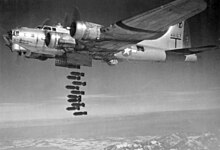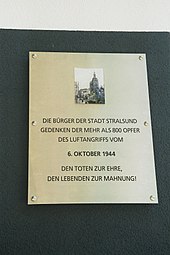Bomb raid on Stralsund on October 6, 1944
The bombing raid on Stralsund on October 6, 1944 was flown by the United States Army Air Forces during World War II as part of the Allied warfare against the German Reich . About 800 people fell victim to it. Large parts of the city of Stralsund were destroyed or damaged.
Attacks before October 6, 1944
By October 6, 1944, only a few bombs had fallen on Stralsund during World War II . More important destinations were in Swinoujscie and Stettin as well as on Usedom . On May 21, 1944, there had been an untargeted emergency drop over Kniepervorstadt, in which no one was injured, but two villas were damaged. Parts of the station area and the sugar factory were destroyed in a light bomb attack on June 18, 1944. On June 20, 1944, an Allied fighter plane crashed on Kleinschmiedstrasse in the city center ; six houses were destroyed there. Most of the bombs fell in the Strelasund .
Life in October 1944
The local "Stralsundische Zeitung" reported in October 1944 about the bombing of German cities. However, since this affected cities far away from Stralsund, the local population was much more affected by the supply situation: the 60-hour workweek had been in effect since mid-September 1944, and more and more women had to replace the male workers who were missing due to the war. In the days before October 6, 1944, many girls and women returned from the so-called Osteinsatz to take home leave or to continue working in Stralsund. This led to a supply bottleneck; the "Stralsundische Zeitung" announced on October 4, 1944 that "for technical reasons, the food cards will not be made available to the party offices until October 7 , where they can be picked up by the block distributors." In the same issue it was described how from dried ones Apple peel tea can be made and that there will be a “break in the delivery of vegetables”; one article was entitled “A Reminder to Parents. If there is an air warning, children from the street. "
The attack


The 379th and 381st Bombardment Group of the 1st Bombardment Division of the 8th Air Force had the order to attack the hydrogenation plant in Pölitz near Stettin . However, due to bad weather over the target area, the 110 B-17 bombers ("Flying Fortresses") and their escort by a large number of P-51 Mustang fighters turned over Peenemünde . In this case, Stralsund was designated as an alternative destination.
At 10 a.m., the German air watch service reported that air force units were approaching from the North Sea. At 11:55 a.m., an air raid alarm sounded in Stralsund because of the bomber formation flying in from the south-east. As so often in the past few days, people went to the cellars.
The Fliegerverband had flown over the island of Rügen and separated an attack squadron of 20 aircraft near the city of Bergen . This flew ahead of the other machines as a "scouting party". Four smoke bombs were dropped over Stralsund .
At 12:30 pm, the first of three waves of attack hit the almost defenseless city: Since Stralsund was classified by the German Reich as "militarily insignificant", the city had only a few anti-aircraft guns. On October 6th, these could not reach the approaching bombers due to their altitude.
The first wave hit the power station and the water supply systematically. Other destinations were the Rügen dam , the port area, the city center and the Franconian suburb . In the Frankenvorstadt, the Reiferbahn , Hafenstrasse and Kleiner and Großer Diebsteig streets were totally destroyed.
A second wave of attacks arrived at around 1 p.m. Goals were again in the city center and the Frankenvorstadt . The immediately following third wave of attacks also targeted these civilian objects.
The attackers turned away at around 2 p.m. A short time later, the all-clear was officially given.
During the attacks, the US bombers dropped around 1,500 high-explosive bombs with individual weights between 100 and 1,000 kilograms, a total of 248 tons. According to the USSAF's war diary, it was 367 tons.
Victim
The first victims were workers in the sugar factory, whose fragmentation bunker had received a direct hit in the first wave of attacks.
The "Stralsundische Zeitung", which only reported on October 9, 1944, only spoke of a "larger number of deaths". Civil registry documents show 679 deaths, a list of names available in the Stralsund city archive puts the number of victims at 685, including 623 people from Stralsund, transitory workers and Soviet forced laborers. Contemporary witnesses spoke of up to 1,000 dead. There is no information on the number of Wehrmacht members killed.
The total number of victims is estimated at 800.
For the German dead, the National Socialist German Workers' Party (NSDAP) ordered mass burials on October 12 and 16, 1944 in the central cemetery .
Damage
The air raid on October 6, 1944, hit around 8,000 apartments in Stralsund. There were between 12,000 and 14,000 homeless .
Of the 2,285 buildings in the city center, 385 were destroyed, as were 133 shops and 17,500 m² of commercial space. The 43 monuments that were destroyed included the Johanniskirche and the cloister in the Johanniskloster , the Semlower Tor , the Wrangelsche Palais and the building of the Schiffercompagnie . 176 houses had suffered damage that made them uninhabitable. 19 percent of all houses in the city and thus almost 47 percent of the urban living space were destroyed.
The high-explosive bombs destroyed entire streets, the incendiary bombs set the city on fire. The rubble made the fire-fighting and rescue work difficult; Extinguishing water could only be taken from the urban ponds, which greatly delayed the rescue.
The telephone connections were working again on October 7, 1944, but the electricity and water supply only days later. Drinking water was brought in from the area with tank boilers.
The cost of repairing the damage in the port alone was estimated at 500,000 Reichsmarks . In addition to damage to the buildings, bridges, quays and bank fortifications, 16 ships were sunk or severely damaged.
reporting
The "Stralsundische Zeitung" reported on October 9, 1944 of the attacks and the damage. A number of the dead were not named. Obituaries were only accepted to a limited extent. Instead, the newspaper reported on the visit of the Gauleiter Franz Schwede-Coburg , who praised the courage of the Stralsund people.
memory
On the occasion of the 60th anniversary of the bombing, students at the Hansa-Gymnasium in Stralsund created extensive documentation of October 6, 1944 in Stralsund. At the same time, the city student council called u. a. in the Ostsee-Zeitung to a city-wide silence to remember the victims. As a final point, the students worked with the Stralsund “mückenschweinverlag” to compile a book on the subject, based on historical facts and contemporary witness reports.
On May 8, 2005, a plaque was placed on a house in Badenstrasse near the town hall with the text “The citizens of Stralsund commemorate the more than 800 victims of the air raid on October 6, 1944. To honor the dead, the living as a warning! “ Appropriate.
See also
literature
- Arno Krause: Stralsund . In: Fate of German Monuments in the Second World War . Edited by Götz Eckardt. Henschel-Verlag, Berlin 1978. Volume 1, pp. 76-84.
- Felix Grundel & Harold Fanning: The Second World War - Bombs on Stralsund . mückenschwein-Verlag, Stralsund 2006.
- Hans-Joachim Hacker : Stralsund in the hail of bombs .: The bomb attack of October 6, 1944 . Redieck & Schade, 2014, ISBN 3942673452
Web links
Individual evidence
- ^ Roger A. Freeman: Mighty Eighth War Diary . JANE's; London, New York, Sydney. 1981 p. 360. ISBN 0 7106 0038 0

